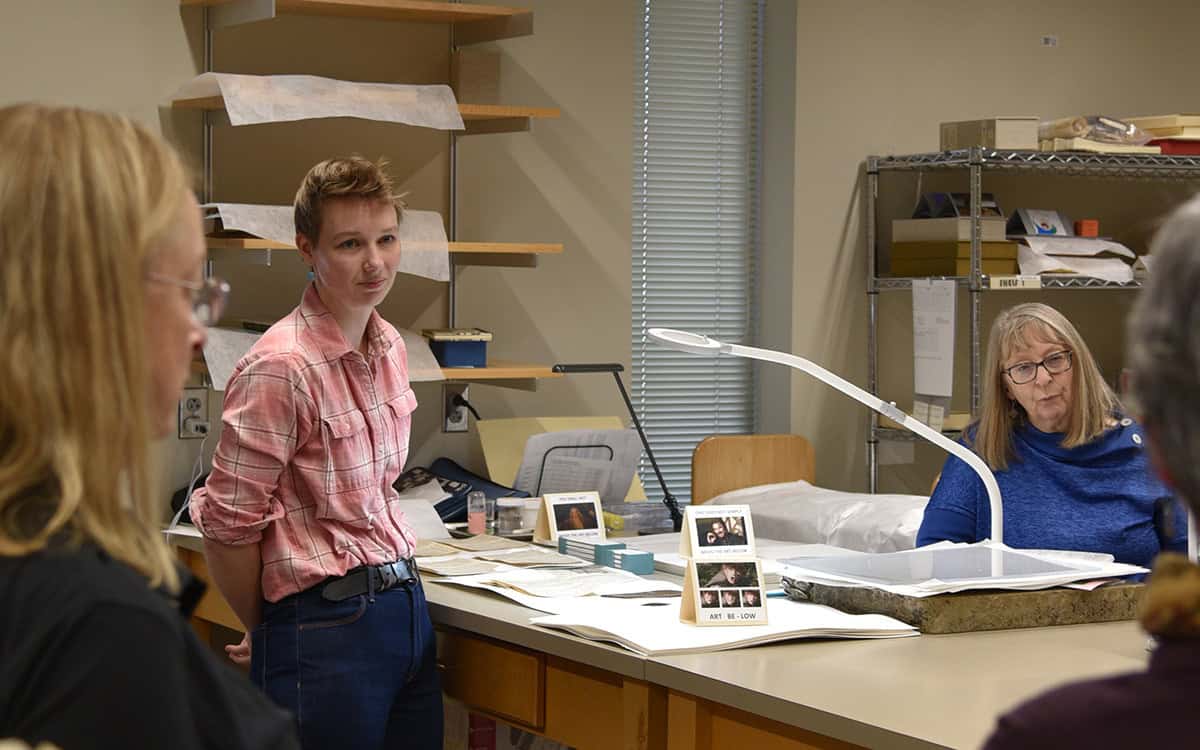The Library and Archives Conservation Education (LACE) fellowship preserves the past while training the conservators of tomorrow.
With impressive collections and a legacy of excellence and innovation, the University of Iowa Libraries have long been known as a leader in the field of book conservation. Now, the reach of that reputation has extended further than ever, thanks to the establishment of the Library and Archives Conservation Education (LACE) internship.

The LACE internship at the Libraries is a rare opportunity for graduate students in conservation programs to combine the daily work of book conservation with the mentorship and guidance of seasoned professionals. Each year, skilled interns receive advanced experience in the practice of book conservation.
These interns come to Iowa from programs in the LACE Consortium, which is made up of SUNY Buffalo State University, University of Delaware, and New York University. Conservation and Collections Care (CCC) at the Libraries is one of a handful of outside programs that LACE schools entrust with training their students. LACE interns receive funding arranged by their home institutions, and this often includes contributions from philanthropic sources, including the Andrew W. Mellon Foundation and the National Endowment for the Humanities. Students placed at the UI receive additional support through enhanced training, funding to attend conferences, and other staff development opportunities.

The consortium forwards applications to CCC with the knowledge that the recipient will develop a deeper understanding of the relationship between a book’s structure and its function. But LACE interns also bring their own considerable knowledge to the worktable, creating a lasting dialogue between institutions.
“I want to make sure interns and our staff have what they need to be successful, whether it be a tool or a piece of equipment, specific training, or the space and time to research a technique or making a book model of a historical structure,” says Giselle Simón, university conservator and the administrator of the LACE internship. “In addition, the advanced interns coming from the LACE programs bring so much: new information, new techniques, and new technologies. It’s an opportunity for us to embrace that, for everyone to learn and grow.”
The LACE intern for the 2023–24 academic year was Katarina Stiller, who was enrolled in the graduate program in art conservation at Winterthur Museum/University of Delaware. Stiller’s program requires students to receive practical training at a partner institution in their third year, the final step before receiving their degree. Stiller was the Libraries’ second-ever LACE intern, and when the time came to apply for internships, she says, the organization’s reputation made it her first choice.
“Iowa was always on my radar as a really good place to learn about bookbinding, book arts, and book conservation,” says Stiller. “This is such a good opportunity for an emerging professional like me. I’m able to get practical experience and form lifelong bonds in my field. I really hope to come back after I graduate, no matter where I end up.”
According to Simón, the LACE internship is something of a new frontier for the conservation field. Now that programs in conservation make it possible for students to train in an academic setting, internships like LACE create a clearer path for students pursuing these careers. For Simón, providing mentorship to LACE interns such as Stiller is a way of paying it forward, creating hands-on learning opportunities while incorporating elements of classroom training.
In Stiller’s case, this meant requesting access to movable books, which Simón was happy to provide.
“I had a lot of say in what sort of projects I’m interested in working on,” says Stiller. “[Simón] actively sought materials I could learn from and challenge myself with.”
One book she repaired during her time in CCC is Johann Remmelin’s Catoptrum microcosmicum, an anatomy book from the 17th century, with movable flaps that peel back to reveal different systems of the body. It’s a teaching copy in its original binding, and generations of medical students would have learned from this exact item, which now lives in the John Martin Rare Book Room at the Hardin Library for the Health Sciences. In Stiller’s hands, it’s a teaching tool once again, an object lesson in paper conservation.
Stiller handles the book with reverence and extreme care, meticulously logging each treatment it receives; in 50 years, another conservator might need to know what chemicals it was exposed to and what procedures were used to extend its shelf life. The Conservation Lab is full of these types of silent conversations, with conservators acting as conduits between past and future. So much learning takes place here—fitting for a discipline that’s all about ensuring that knowledge passes safely from one generation of learners to the next.
Simón hopes to strengthen the LACE internship’s presence at the Libraries in the years ahead, further cementing the institution’s reputation as a training ground for tomorrow’s top conservators. That includes Stiller, who graduated in August 2024 and is now undertaking an advanced post-graduate conservation residency at Northwestern University in Evanston, Illinois.
